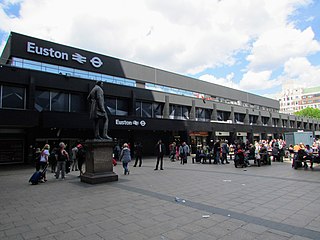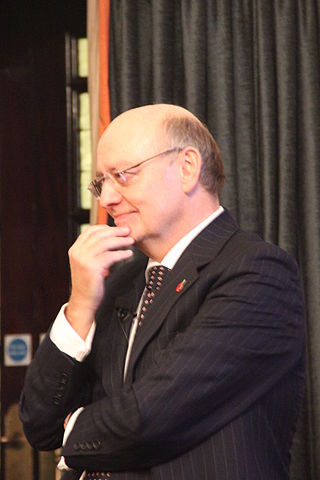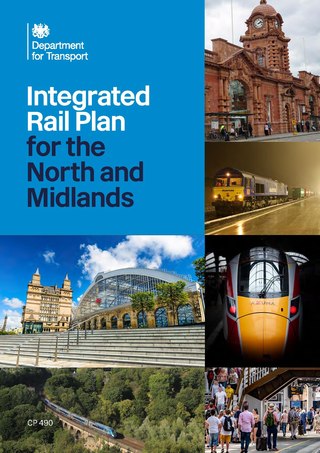Related Research Articles

Euston railway station is a major central London railway terminus managed by Network Rail in the London Borough of Camden. It is the southern terminus of the West Coast Main Line, the UK's busiest inter-city railway. Euston is the tenth-busiest station in Britain and the country's busiest inter-city passenger terminal, being the gateway from London to the West Midlands, North West England, North Wales and Scotland.

Transport in England includes road, rail, air, and water networks.

Sir John Alexander Armitt is an English civil engineer, and current chairman of the UK's National Infrastructure Commission.
Stephen Glaister is Emeritus Professor of Transport and Infrastructure at the Department of Civil & Environmental Engineering, Imperial College London, where he was also director of the Railway Technology Strategy Centre.

High Speed 2 (HS2) is a high-speed railway which is under construction in England. The line will run between Handsacre, in southern Staffordshire, and London, with a spur to Birmingham. HS2 is to be Britain's second purpose-built high-speed railway after High Speed 1, which connects London to the Channel Tunnel. London and Birmingham will be served directly by new high speed track, and services to Glasgow, Liverpool and Manchester will use a mix of new high speed track and the existing West Coast Main Line. The majority of the project is planned to be completed by 2033.

Sir David Hartmann Higgins is an Australian-British businessman, the Chairman of United Utilities Group, Chairman of Gatwick Airport, and the former Non-Executive Chairman of High Speed Two (HS2). He was Chief Executive of the London 2012 Summer Olympics Delivery Authority and Network Rail.

Robert James Mair, Baron Mair, is a geotechnical engineer and Emeritus Sir Kirby Laing Professor of Civil Engineering at the University of Cambridge. He is the Founding Head of the Cambridge Centre for Smart Infrastructure and Construction (CSIC). He was Master of Jesus College, Cambridge, from 2001 to 2011 and a fellow of St John's College, Cambridge, from 1998 to 2001. In 2014 he was elected a vice president of the Institution of Civil Engineers and on 1 November 2017 became the Institution's president for 2017–18, its 200th anniversary year. He was appointed an independent crossbencher in the House of Lords in 2015 where he has been active on matters relating to infrastructure, science and technology, and education. He was a member of its Select Committee on Science and Technology for four years, and has also been a member of Select Committees on Assessment and Management of Risk, and Education and Skills; he is presently a member of the Select Committee on the Built Environment.
Heathrow Hub railway station was a proposed interchange that would serve – mainly – a now disbanded potential alignment of High Speed 2 (HS2) services that would adjoin the expanded part of Heathrow Airport, England. It was a cornerstone part of an expansion plan put forward in 2008, by engineering firm Arup, to set up the UK's first high-speed rail network north-west of London.
Sir Allan Stephen Quartermaine, was a British civil engineer. He started his career in the Hertfordshire county surveyor's office and served in the Royal Engineers during the First World War, constructing railways in the Middle East and being awarded the Military Cross. After the war he continued to work for local authorities before joining the Great Western Railway (GWR), where he became chief engineer by 1940. During the Second World War he served as Director-General of Aircraft Production Factories before returning to the GWR to construct military railway facilities. After the war he refused a position on the Railway Executive of the British Transport Commission as he disagreed with nationalisation of the railways. Despite this he transferred to become chief engineer of the Western Region of British Railways in 1948 and later served as an adviser to British Rail on modernisation. Quartermaine served as president of the Institution of Civil Engineers for 1951–52 and was knighted in 1956.

Andrew George Stephenson FRSA is a former British politician who most recently served as Minister of State for Health and Secondary Care from November 2023 to July 2024. A member of the Conservative Party, he was the Member of Parliament (MP) for Pendle in Lancashire from 2010 until 2024.

Peter George Hansford is an English civil engineer. He served as the 146th President of the Institution of Civil Engineers (ICE) (2010-2011) and succeeded Paul Morrell as the UK government's chief construction adviser in November 2012.

Northern Powerhouse Rail (NPR), sometimes referred to unofficially as High Speed 3, is a proposed major rail programme designed to substantially enhance the economic potential of the North of England. The phrase was adopted in 2014 for a project featuring new and significantly upgraded railway lines in the region. The aim is to transform rail services between the major towns and cities, requiring the region's single biggest transport investment since the Industrial Revolution. The original scheme would have seen a new high-speed rail line from Liverpool to Warrington continuing to join the HS2 tunnel which it would share into Manchester Piccadilly station. From there, the line would have continued to Leeds with a stop at Bradford. The line was intended to improve journey times and frequency between major Northern cities as well as creating more capacity for local service on lines that express services would have been moved out from.
Mark Carne is a British businessman who served as executive vice-president for Shell in the Middle East and North Africa and was chief executive of Network Rail.
Rachel Susan Skinner is a British civil engineer with Canadian-based consultant WSP Global. She was named one of the Daily Telegraph Top 50 Influential Women in Engineering in 2016 and both the Best Woman Civil Engineer and the Most Distinguished Winner at the European Women in Construction and Engineering Awards in 2017. Skinner became the youngest president of the Institution of Civil Engineers in 2020. In 2019, she was elected a Fellow of the Royal Academy of Engineering (FREng). She was appointed CBE for services to infrastructure in the 2022 New Year Honours.

HS4Air is a proposal for a 140-kilometre (87 mi) high-speed railway line in the United Kingdom, put forward in 2018 by a British engineering consultancy, Expedition Engineering.

Olawale Nelson Ogunshakin OBE is a British engineer and businessman. He is currently chief executive officer of the International Federation of Consulting Engineers (FIDIC) based in Geneva, Switzerland. He was appointed to the board of Transport for London in September 2016.

The Irish Sea Bridge, sometimes called the Celtic Crossing by the media, is a hypothetical rail and road bridge that would span the Irish Sea and connect the island of Ireland to the island of Great Britain. It is one of a number of such proposed fixed sea links across Ireland and Britain. The bridge's length would depend upon the route taken; one such route, known as the Galloway route, would cross the North Channel, close to that taken by an existing ferry service, between Portpatrick in Dumfries and Galloway, and Larne in County Antrim, Northern Ireland, a distance of 45 kilometres (28 mi).

The Colne Valley Viaduct is a bridge, under construction as of 2024, which will carry the High Speed 2 railway over the Colne Valley Regional Park and the Grand Union Canal, in Hillingdon, west London. When completed, its length of 3.4 kilometres (2.1 mi) and a weight of 116,000 tonnes will make it the largest railway bridge in the UK. It is one of the largest single civil engineering works of HS2 Phase 1.
The Chiltern Tunnel is a high-speed railway tunnel currently under construction in Buckinghamshire and Hertfordshire, England, and will upon completion carry the High Speed 2 (HS2) railway line under the Chiltern Hills. The twin-bore tunnels, which are 16.04 km long, will be the longest on the HS2 line. Each tunnel will also have additional 220 m (720 ft) entry and 135 m (443 ft) exit perforated concrete portals to reduce sudden changes in air pressure and subsequent noise.

The Integrated Rail Plan for the North and Midlands or more simply, the Integrated Rail Plan (IRP), is a United Kingdom government proposal published on 18 November 2021. It aims to deliver "increased capacity, faster journeys or more frequent services on eight out of the top ten busiest rail corridors across the North and Midlands", by developing rail services along with the required infrastructure in these regions of England. It was published by the Department for Transport (DfT) and features forewords by Prime Minister Boris Johnson and Transport Secretary Grant Shapps, but its publication was delayed a number of times, partly because of the COVID-19 pandemic. It contains the significant proviso that "In line with the Government's existing approach to rail enhancements, commitments will be made only to progress individual schemes up to the next stage of development, subject to a review of their readiness." A Technical Annexe was published in January 2022. A correction slip was issued March 2022.
References
- ↑ Stephen, Paul (28 August 2019). "Industry and business leaders back HS2 as review launched". Rail . 886: 28.
- 1 2 "Institution of Civil Engineers - Past presidents". 22 August 2010. Archived from the original on 22 August 2010. Retrieved 23 August 2019.
- ↑ "Douglas Oakervee knighted by Queen in New Year Honours". Construction Enquirer. Retrieved 3 January 2022.
- 1 2 "Douglas Oakervee: 'I think the name HS2 is unfortunate'". The Independent. 8 September 2013. Retrieved 4 September 2019.
- ↑ "The Lighthouse Q3 2022". issuu.com. 13 October 2022. pp. 16–21. Retrieved 24 October 2023.
- 1 2 Walker, Jonathan (17 June 2019). "Former HS2 chairman to lead review of new rail line". Birmingham Post. Retrieved 9 September 2019.
- ↑ "Government announces independent review into HS2 programme". GOV.UK. Department for Transport. 21 August 2019. Retrieved 21 August 2019.
- ↑ "HS2 independent review: terms of reference". GOV.UK. Retrieved 21 August 2019.
- ↑ "Oakervee Review". Department for Transport. Retrieved 12 February 2020.
original rationale for HS2 – still holds: there is a need for greater capacity (both more trains on tracks and more seats on trains and reliability on the GB rail network)
- ↑ "Study to explore feasibility of fixed link across the Irish Sea". Bridge Design & Engineering. 5 October 2020. Retrieved 10 December 2020.
- ↑ Webster, Laura (6 November 2020). "Boris Johnson 'now considering rail tunnel between Scotland and Northern Ireland'". The National. Retrieved 10 December 2020.
- ↑ "New Year Honours: Diplomatic and Overseas". BBC News. Retrieved 14 November 2021.
- ↑ Lynch, Andrew (7 April 2013). "Leading edge: Douglas Oakervee". Sunday Times . ISSN 0956-1382 . Retrieved 4 September 2019.
- ↑ "Birthday Honours 2010: CSV - GOV.UK". assets.publishing.service.gov.uk. Retrieved 14 November 2021.
- ↑ "Presidents". The Smeatonian Society of Civil Engineers. Retrieved 14 November 2021.
- ↑ "No. 63571". The London Gazette (Supplement). 1 January 2022. p. N2.